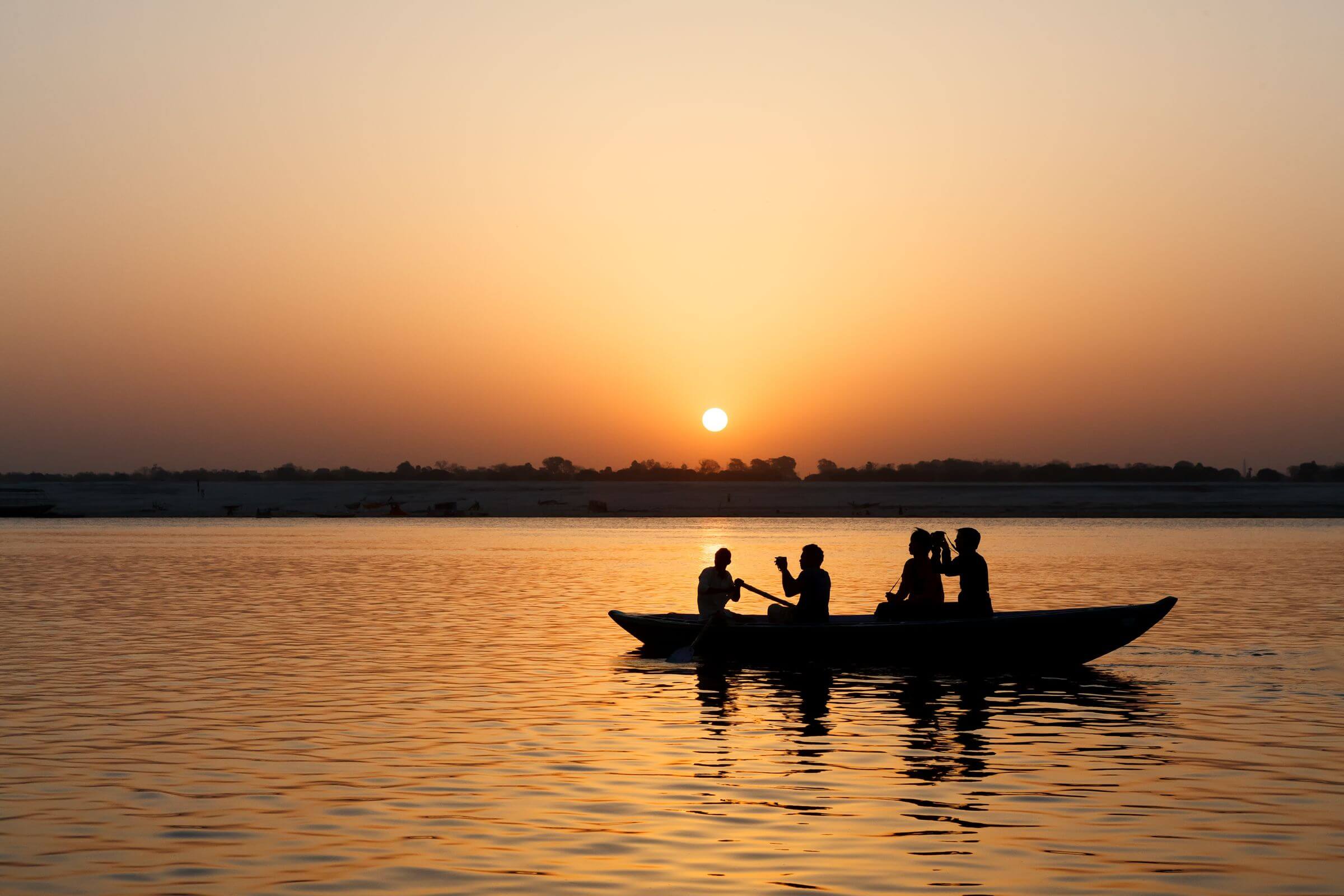
The ancient city of Varanasi on the Ganges River in India has a sunset cruise unlike any other in the tourist book. The attraction isn’t beer, romance, or the last colors of the solar show. Instead, the main event is the funeral pyres along the river.
My boat, filled with Indian tourists, chugged upriver to some 40 yards from one of the outdoor crematoria. Then the barefoot boy steering it turned off its engine. On shore, I could see a shape atop a platform engulfed in flames five feet high. The talking stopped. A few took photos or videos.
It seemed invasive to me, but death is not a subject kept from public view here. It’s out in the open, a daily reminder of where things are ultimately headed—and we don’t know when. This can be instructive to all of us, a motivation to seize the time we do have to live to the fullest and have better work-life balance, something we can let all manner of things get in the way of.
Noting the elephant in the mortal room is helpful on another very important front too. A big part of the fear of death is the fear of never having lived. Another reason to leave no life experiencing on the table.
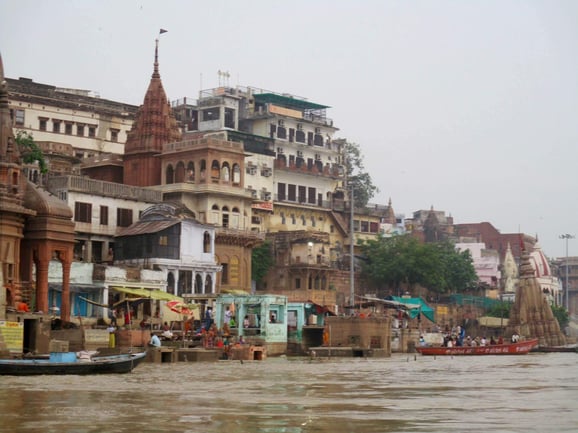
NEXUS OF BELIEFS
The ill and dying come from all over India to leave the mortal world on the banks of the Ganges, whose waters they believe guarantee redemption for believers. The river is sacred to Hindus, known as Mother Ganga, named after the goddess Ganga.
While the family of the individual at the cremation site mourned the loss, they would also be gladdened that their loved one had departed at this auspicious location.
It’s a scene that has been repeated for hundreds of years in one of the oldest cities in the world, known for a long time as Benares. Traces of settlement here reach back to 1800 B.C. Enter its labyrinthine alleyways off the river, and you are back in a medieval warren of narrow passages, some blocked by cows, sacred here, and folks selling homemade food, candles, statues of Hindu gods, and bamboo fans.
Once known for its silk fabrics and sculptures, Varanasi today is renowned as a spiritual hub. It’s the nexus of two of the world’s major religions—Hinduism and Buddhism. Buddha is said to have delivered his first sermon in the fifth century B.C. at Sarnath, a town outside Varanasi that has some very interesting Buddhist sites, including the ruins of a massive fifth-century A.D. temple complex and a museum of remarkable artifacts dug up from it.
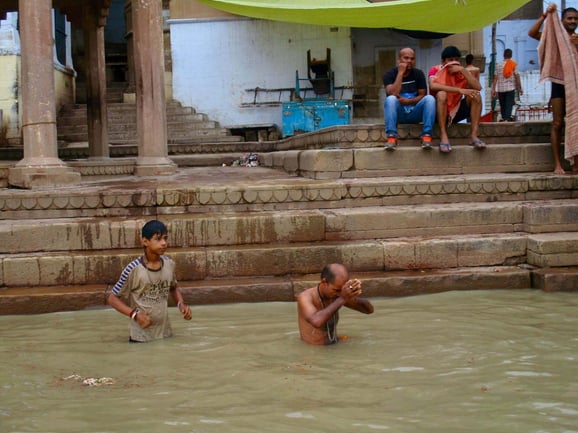
Temples and offering sites line Varanasi’s riverbank ghats, cement steps that lead down to the Ganges to help the faithful immerse themselves, bathe, or collect its murky water, which, though held sacred, is highly polluted.
I threaded my way to the river through throngs of pilgrims dressed in orange, some of whom had walked upwards of 100 miles, some barefoot, to collect water from the Ganges to bring back to their local Shiva temples in a ritual known as the Yatra pilgrimage. One young man without shoes was limping. He’d hurt his foot on the long walk from his village, but he said he would keep going. He was almost there.
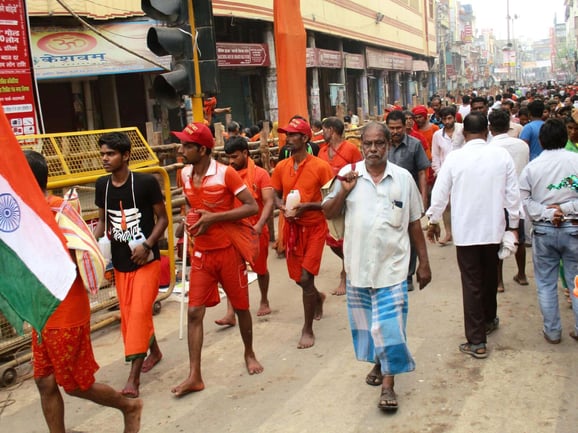
An old sadhu, or Hindu holy man, with a long gray beard chanted in the middle of the street, where cows dozed. Religious songs blared from speakers as pilgrims pushed through a din of motorcycle horns and trishaws. It was rush-hour at 5:30 a.m.
THE ILLUSORY EXPANSE OF TOMORROW
Though the practices along the river might seem shocking or morbid to some, maybe we could use a shock. We are expert at evading the topic of mortality most of our lives in the West, aside from those in the medical, law enforcement, or CSI murder mystery fields. It can give us a false sense of security and lack of urgency about taking care of the life side, a sense that there’s plenty of time left. There’s always tomorrow.
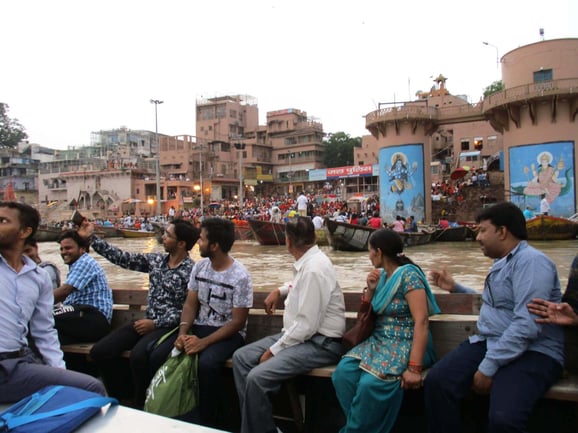
The writer Paul Bowles had a great take on this illusory expanse of tomorrow in A Sheltering Sky. “Because we don’t know when we will die, we get to think of life as an inexhaustible well. Yet everything happens only a certain number of times, and a very small number, really. How many more times will you remember a certain afternoon of your childhood, some afternoon that’s so deeply a part of your being that you can’t even conceive of your life without it? Perhaps four or five times more. Perhaps not even that. How many more times will you watch the full moon rise? Perhaps twenty. And yet it all seems so limitless.”
A friend of mine had a heart attack and died at 41. One of my best friends died in a work accident last year, with a recreational vehicle he’d just purchased to cruise the U.S. in retirement parked outside his house. Michael Justice was one of the best photographers in the U.S. He had documented the world’s largest pilgrimage, some 15 million people, in Allahabad, up the Ganges from here and had done some great work in Varanasi. My trip on the river was in tribute to him.
Heather Burcham thought she had plenty of time, but then the Texan came down with cervical cancer in her late-20s. As I reported in my book, Don’t Miss Your Life, once she learned the disease was terminal, she decided to get as much living in as she could, taking up skydiving and putting her remaining strength to work to lobby for a state law to support a vaccine that could prevent young women from contracting the disease. I saw her on an ABC News report. She said something I won’t ever forget, “You are so lucky. You get to live every moment.”
And we are. Except we often don’t realize our good fortune, remaining caught up in worries and trying to fill our time, instead of focusing on ways to make the time fulfilling. How do we do that? Not by waiting for someone else to do it for us.
YOU ARE THE ENTREPRENEUR OF YOUR LIFE
It starts by becoming the entrepreneur of your life. The science says that our overriding mandate is to determine the content of our life, to put our stamp on it, to write our own script, to participate and not be a spectator, because that is when we satisfy core needs, such as autonomy, competence, and relatedness, or connection with others.
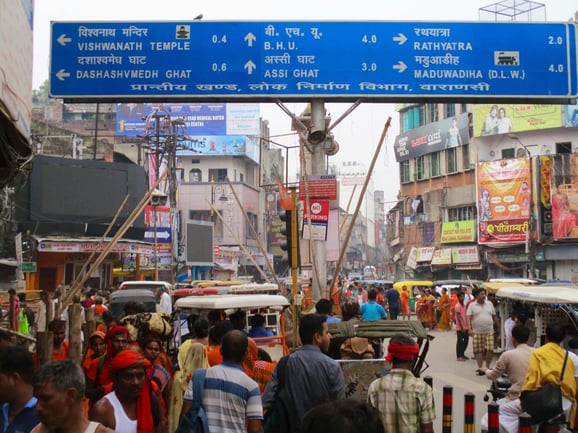
There is no arena better for doing that than in our life outside the job. This is where autonomy lives, in our choosing of how we want to experience our world. Researchers have found that 50% of our potential happiness is genetic. Sorry about that. Another 10% of potential happiness is circumstance, the state of your health, the environment you are raised in. Again, sorry. The good news is that we control the other 40%, which falls into a realm known as intentional activities.
The key to sustainable happiness, as researchers Sonja Lyubomirsky and Kennon Sheldon have reported, is initiating intentional activities and then sustaining them. So with that in mind, let’s take a look at how we can get started on a life of no regrets. Keep in mind that we regret more the things we don’t do than what we do. It’s called the “inaction effect.”
6 ANTIDOTES TO REGRET
1. Get rid of stress. The culture tells us to suck it up. Don’t. When we don’t dispute stress and resolve it, we think about it. That’s what drives stress, rumination. Stress suppresses the play equipment in your brain. The last thing a part of your brain that thinks you’re going to die that second wants to do is have fun. Stress is a story, a false belief we tell ourselves about the stressful event. We can and have to turn stress off and turn on stress management to open up receptivity to life.
2. Identify engaging life activities. Engagement is the key. Passive activities, such as watching TV, don’t cut it. The average state of someone watching TV, says Mihaly Csikszentmihalyi, author of Optimal Experience, is a mild depression. Go online, research areas of interest. Make a list of affinities, local activities, potential hobbies, summer vacation destinations, road trips, and bucket list items.
3. Initiate to participate. Just do it. Get going. Jump in without worrying about whether it’s perfect or you have everything figured out, as you did as a child. Make a commitment to live like Heather Burcham. Now.
4. Learn something new. Where can you go, what can you do to learn something new today? The brain’s party drug, dopamine is triggered at the mere prospect of something new. It’s called the exploration bonus. We are all explorers, if we follow our interests and curiosities.
5. Travel more. There’s nothing that turns on the brain’s satisfaction equipment like travel. The brain craves novelty and challenge. That is the definition of going somewhere you haven’t been before. Travel immerses us in novel experiences, wakes us up to our lives and offers insights and reflections, like those that come on a river trip in Varanasi, that remind us of things we need to pay attention to.
6. Use the play mind. The work mind doesn’t know how to play. This is because its focus is all on results. Play and the life side is about the experience, not where it’s going or an instrumental payoff. We do it to do it, for the fun, amusement, challenge, not to get anything external out of it.
We are going to have three questions at the end of our days, said Erik Erikson, the great psychologist who studied the stages of life and worked with seniors: 1) Did I get what I came her for? 2) Was it a good time? And 3) Did I do what I wanted?
When we proactively put life on the calendar, we can answer a resounding "YES" to these questions and insure a life without the regrets of inaction.
If you would like to learn more about increasing work-life balance and the skills of life satisfaction, click the button below for details on my keynotes and training programs. Thanks.



